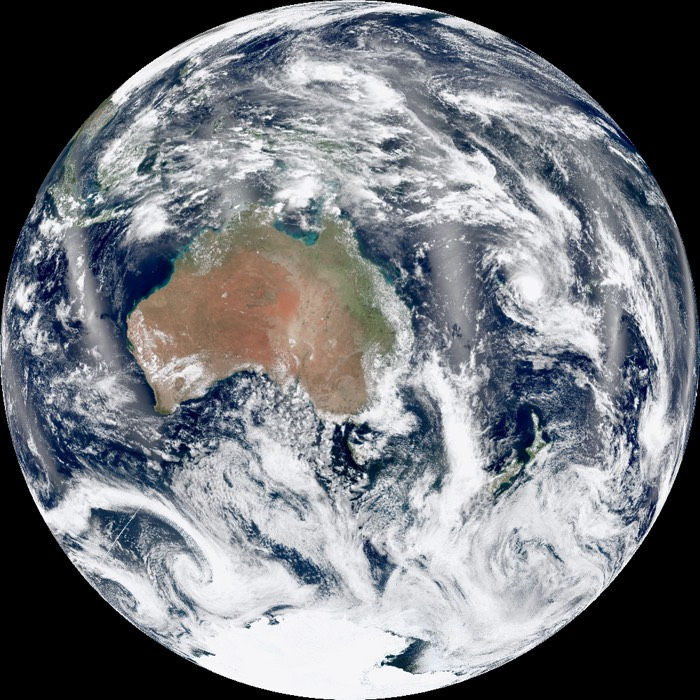Slowing of Earth's Spin Revealed in Ancient Astronomers' Tablets

The work of ancient astronomers reveals that the Earth's spin is slowing down — though not as much as scientists believed.
Each century, the length of the solar day, or the time it takes the planet to do a full rotation, grows by 1.8 milliseconds, according to a new study using astronomical observations going back to 750 B.C. Researchers have known that the planet's rotation is slowing because of friction caused by the tides, as water that's being tugged on by the moon's gravity sloshes against the solid Earth. However, measurements of this tidal effect suggest that the planet should be slowing in its rotation by 2.3 milliseconds per century, slightly more than the new research finds.
The difference between 2.3 milliseconds and 1.8 milliseconds over a century may seem trivial, said study researcher Leslie Morrison, who worked at the Royal Greenwich Observatory for nearly 40 years. But those fractions of milliseconds are important for understanding the ways that the Earth has changed shape since the end of the last ice age, about 12,000 years ago, Morrison told Live Science. [50 Amazing Facts About Planet Earth]
Ancient records
Morrison and his colleagues have been working on measuring the Earth's rotation for decades. The new study is perhaps the most comprehensive effort yet, Morrison said, mostly because the ancient Babylonians were so good at keeping records.
By 720 B.C., this civilization, located in what is now Iraq, was keeping records on clay tablets in a written language called cuneiform. When archaeologists discovered some of these tablets in Babylonian ruins in the 1800s, the language had been lost; it took decades to decipher those original tablets.
Fortunately for modern-day Earth scientists, some of these tablets happened to contain records of eclipses, particularly solar eclipses, when the moon moves between the sun and the Earth, casting a shadow on this planet. These eclipses tended to make an impression on ancient people, Morrison told Live Science. The events also strengthened tides slightly, because the alignment between the Earth, moon and sun meant a stronger pull on the planet and its oceans.
"The descriptions of a total solar eclipse are so graphic," he said, including descriptions like, "When the days suddenly turn to night and the stars appear."
Get the Space.com Newsletter
Breaking space news, the latest updates on rocket launches, skywatching events and more!
The researchers also collected eclipse observation records from ancient China, ancient Greece and the ancient Arab regions. The timing of the eclipses from these descriptions, however, conflicts with calculations of when the eclipses should have occurred if tidal friction alone explained the slowdown of the planet's rotation. In 720 B.C., Morrison said, the discrepancy was about 7 hours between what the tablets reported and what calculations based on the tidal models would have predicted.
"That discrepancy is the measure of how much the Earth has been changing over this period of time," Morrison said. Working backward from the discrepancy, the team calculated how long the days have lengthened over the centuries. He and his colleagues published their findings today (Dec. 6) in the journal Proceedings of the Royal Society A.
Geophysical parameters
Calculating the Earth's rotation time down to less than a millisecond matters because that number says something about the way the very shape of the planet has changed, said Duncan Agnew, a geophysicist at the University of California, San Diego, who was not involved in the new study.
The major change since 720 B.C. relates to the end of the last ice age, Agnew said. The planet is like a memory-foam mattress, Agnew said, gradually rebounding as the ice retreats. The glaciers retreated 12,000 years ago, but the Earth has taken its time in bouncing back during the time that it's been relieved of their weight. That change in shape alters Earth's rotation, much as a figure skater can change the speed of a spin by drawing her or his arms in or throwing them out wide. [Images of Melt: Earth's Vanishing Ice]
That shape change, which requires knowing the precise speed of the spin to calculate, is key for many other geophysical calculations, Agnew told Live Science. For example, when measuring sea-level change, climate scientists must be able to account for changes in the land.
"This data gives us another piece of information," Agnew said.
Morrison and his colleagues also used data on lunar occultation, or times when the moon passes in front of a star, blocking it from view, collected since the 1750s. Changes in Earth's rotation since that time are probably mostly due to changes in the dynamics of the liquid-iron core deep in the center of the Earth, Agnew said. Very little is known about this liquid core, so the measurements of its effect on the planet's spin are important for future research, he said.
This might seem like a bit of a dry subject, Agnew said, if it weren't for the staggering fact that all of these measurements would be impossible to calculate if fellow humans hadn't felt compelled to record astronomical events thousands of years ago.
"There were a bunch of guys back in what is now Iraq 2,500 years ago putting things in clay tablets. … They weren't thinking that 2,500 years later somebody was going to be writing a paper about Earth rotation," Agnew said. Those tablets were later lost and buried, only to be discovered by future generations of enterprising Homo sapiens.
"It's kind of amazing that this information exists at all," Agnew said.
Original article on Live Science.
Join our Space Forums to keep talking space on the latest missions, night sky and more! And if you have a news tip, correction or comment, let us know at: community@space.com.

Stephanie Pappas is a contributing writer for Space.com sister site Live Science, covering topics ranging from geoscience to archaeology to the human brain and behavior. She was previously a senior writer for Live Science but is now a freelancer based in Denver, Colorado, and regularly contributes to Scientific American and The Monitor, the monthly magazine of the American Psychological Association. Stephanie received a bachelor's degree in psychology from the University of South Carolina and a graduate certificate in science communication from the University of California, Santa Cruz.

